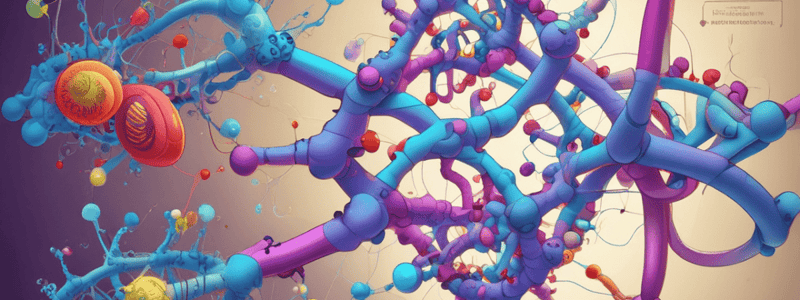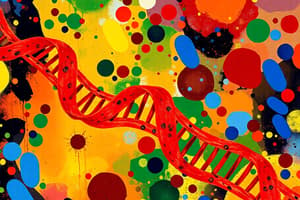Podcast
Questions and Answers
What is the primary function of RNA polymerase during transcription?
What is the primary function of RNA polymerase during transcription?
- To translate the RNA sequence into a polypeptide chain
- To polyadenylate the 3' end of the RNA
- To add a cap to the 5' end of the RNA
- To read the DNA template and match incoming nucleotides (correct)
What is the primary function of the cap structure at the 5' end of the RNA?
What is the primary function of the cap structure at the 5' end of the RNA?
- To stabilize the RNA and prevent degradation
- To recruit ribosomes for translation
- To enhance translation efficiency
- All of the above (correct)
What is the purpose of polyadenylation?
What is the purpose of polyadenylation?
- To stabilize the RNA and enhance translation efficiency (correct)
- To add a cap to the 5' end of the RNA
- To transcribe the DNA template into an RNA molecule
- To initiate translation by binding ribosomes to the mRNA
What is the first step in the translation process?
What is the first step in the translation process?
What is the role of the ribosome in the translation process?
What is the role of the ribosome in the translation process?
What is the final product of the translation process?
What is the final product of the translation process?
What is the result of the desamination of adenines in tRNA?
What is the result of the desamination of adenines in tRNA?
What is the function of the snoRNP C/D in archaea?
What is the function of the snoRNP C/D in archaea?
What is the role of Nop5, Nop56, and Nop58 proteins in the snoRNP C/D?
What is the role of Nop5, Nop56, and Nop58 proteins in the snoRNP C/D?
What is the function of fibrillarin (Fib) in the snoRNP C/D?
What is the function of fibrillarin (Fib) in the snoRNP C/D?
What is the structure of the snoRNP H/ACA?
What is the structure of the snoRNP H/ACA?
What is the role of Cbf5 in the snoRNP H/ACA?
What is the role of Cbf5 in the snoRNP H/ACA?
What is the proposed structure of the snoRNP H/ACA?
What is the proposed structure of the snoRNP H/ACA?
What is the term used to describe the correction of RNA sequences?
What is the term used to describe the correction of RNA sequences?
What is the result of desaminating the citosine in the triplete CAA?
What is the result of desaminating the citosine in the triplete CAA?
What type of modification can occur in the RNA sequence of some organisms?
What type of modification can occur in the RNA sequence of some organisms?
What is the consequence of desaminating the citosine in the triplete CAA?
What is the consequence of desaminating the citosine in the triplete CAA?
What is the role of the citidina-desaminasa and adenosina desaminasa enzymes?
What is the role of the citidina-desaminasa and adenosina desaminasa enzymes?
What is the consequence of a deficiency or hyperactivity in the adenosina desaminasa enzyme?
What is the consequence of a deficiency or hyperactivity in the adenosina desaminasa enzyme?
Where are the majority of the targets of RNA editing found in invertebrates and vertebrates?
Where are the majority of the targets of RNA editing found in invertebrates and vertebrates?
What is the current understanding of the biofisical and physiological changes caused by A to I editing in invertebrates and vertebrates?
What is the current understanding of the biofisical and physiological changes caused by A to I editing in invertebrates and vertebrates?
What is the difference between the RNA editing process in invertebrates and vertebrates?
What is the difference between the RNA editing process in invertebrates and vertebrates?
What is the main reason why multiple proteins can be obtained from a single gene?
What is the main reason why multiple proteins can be obtained from a single gene?
What is the consequence of desamination of a C to a U in a codon CAA in the intestine?
What is the consequence of desamination of a C to a U in a codon CAA in the intestine?
What is the purpose of writers and erasers in post-transcriptional modifications of mRNAs?
What is the purpose of writers and erasers in post-transcriptional modifications of mRNAs?
What is the effect of methylation in position 1 of adenine on hydrogen bonding?
What is the effect of methylation in position 1 of adenine on hydrogen bonding?
What determines the fate of a messenger RNA in the cytoplasm?
What determines the fate of a messenger RNA in the cytoplasm?
What is the consequence of having multiple forms of apolipoprotein in different tissues?
What is the consequence of having multiple forms of apolipoprotein in different tissues?
What is the role of readers in post-transcriptional modifications of mRNAs?
What is the role of readers in post-transcriptional modifications of mRNAs?
What is the main difference between the apolipoprotein in the liver and intestine?
What is the main difference between the apolipoprotein in the liver and intestine?
What is the effect of methylation in position 6 of adenine on hydrogen bonding?
What is the effect of methylation in position 6 of adenine on hydrogen bonding?
What is the purpose of metylations in the life of messenger RNAs?
What is the purpose of metylations in the life of messenger RNAs?
What is the primary role of metilations in mRNA?
What is the primary role of metilations in mRNA?
What is the term used to describe the set of modifications in mRNA?
What is the term used to describe the set of modifications in mRNA?
What is the purpose of the co-transcriptional addition of metilations to mRNA?
What is the purpose of the co-transcriptional addition of metilations to mRNA?
What is the fate of mRNA molecules that are not translated into protein?
What is the fate of mRNA molecules that are not translated into protein?
What is the function of the proteins that recognize metilations in mRNA?
What is the function of the proteins that recognize metilations in mRNA?
Why are most metilations in mRNA found outside of the reading frame?
Why are most metilations in mRNA found outside of the reading frame?
What is the result of having different patterns of metilations in mRNA molecules?
What is the result of having different patterns of metilations in mRNA molecules?
What is the role of metiltransferases in the epitranscriptomics process?
What is the role of metiltransferases in the epitranscriptomics process?
What is the main difference between DNA replication and epitranscriptomics?
What is the main difference between DNA replication and epitranscriptomics?
What is the relationship between the pattern of metilations and the translation of mRNA into protein?
What is the relationship between the pattern of metilations and the translation of mRNA into protein?
Flashcards are hidden until you start studying
Study Notes
mRNA Structure and Synthesis
Transcription
- Process of creating a complementary RNA copy from a DNA template
- Initiated when an enzyme called RNA polymerase binds to the DNA template
- RNA polymerase reads the DNA template and matches the incoming nucleotides to the base pairing rules (A-T, G-C)
- The resulting RNA molecule is complementary to the DNA template
Capping
- Addition of a specialized structure called a cap to the 5' end of the newly synthesized RNA
- The cap is composed of 7-methylguanosine (m7G) and is attached to the first nucleotide of the RNA
- Functions:
- Protects the RNA from degradation
- Helps to recruit ribosomes for translation
- Enhances translation efficiency
Polyadenylation
- Process of adding a long string of adenine nucleotides (poly(A) tail) to the 3' end of the RNA
- Occurs after transcription is complete
- Functions:
- Stabilizes the RNA and prevents degradation
- Enhances translation efficiency
- Helps to transport the RNA out of the nucleus
Translation
- Process of using the mRNA sequence to build a polypeptide chain
- Occurs in the cytoplasm
- Steps:
- Initiation: Ribosome binds to the mRNA and reads the start codon
- Elongation: Amino acids are brought to the ribosome and added to the growing polypeptide chain
- Termination: The ribosome reaches the stop codon and releases the completed polypeptide chain
Splicing
- Process of removing introns (non-coding regions) and joining exons (coding regions) to form a mature RNA
- Occurs in the nucleus
- Steps:
- Recognition: Spliceosomes recognize the intron-exon boundaries
- Cleavage: The intron is cleaved from the RNA
- Ligation: The exons are joined together to form a mature RNA
Studying That Suits You
Use AI to generate personalized quizzes and flashcards to suit your learning preferences.




